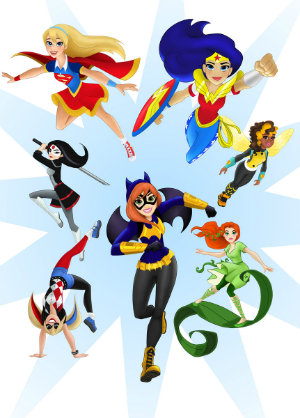DC and WB Launch “Super Hero Girls” Product Lines, Because Inclusion Is Hard
 |
You can read the whole thing, but I’ll focus on the parts that seem key.
Developed for girls aged 6-12, DC Super Hero Girls centers on the female Super Heroes and Super-Villains of the DC Comics universe during their formative years–prior to discovering their full super power potential. Featuring a completely new artistic style and aesthetic, DC Comics’ icons such as Wonder Woman, Supergirl, Batgirl, Harley Quinn, Bumble Bee, Poison Ivy, Katana and many more make their unprecedented teenaged introduction. Each character has her own storyline that explores what teen life is like as a Super Hero, including discovering her unique abilities, nurturing her remarkable powers and mastering the fundamentals of being a hero.
It’s going to include books and Lego sets (which will presumably be in the “Friends” style) and “a line of characters for the action figure category, an area of the industry that has been primarily developed with boys in mind, and fashion dolls featuring strong, athletic bodies that stand on their own in heroic poses.”
Dolls that stand on their own? Heavens!
Funny – I thought we were supposed to not like when toy companies with theoretically gender-neutral appeal make gratuitously girl-targeted spin-offs like Lego Friends. I thought the problem with comics and action figures was that women weren’t included enough – not that they needed a separate-but-equal universe that’s equally polarizing. Then again, my wife was always fond of pink-box products aimed at girls, so maybe this is a good call. I’m just curious what action figures – as opposed to fashion dolls – aimed at girls will look like, and if they’re somehow different from She-Ra, who it seems to me was an action figure aimed at girls, and ought to take offense at Mattel claiming they’ve never done such a thing before. My cousin Ming used to love Kenner Super Powers – she just wished Wonder Woman wasn’t the only girl in the line. But she insisted they were already toys meant for girls.
It feels to me like the same thing WB and DC are doing in movies. “Oh, you like Marvel movies? Here’s our copy of that, mapped out for the next 20 years! Oh, you want stuff for girls? Here are a bunch of girl toys! We’ll call ’em ‘Super Hero Girls’ just so you know!” All style and market-speak.(You’ll never see them call a line “Super Hero Boys.” Once again, boys are the default and girls are the “other.”)
I think we have a podcast topic for Julia and me this week. And I shouldn’t have to say this, but a few recent incidents compel me to state outright: if we can avoid misogynist language in comments, that would be super, thanks.

